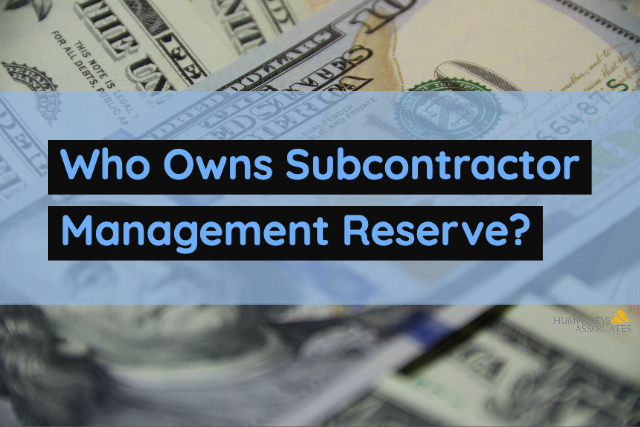Who Owns Subcontractor Management Reserve (MR)?

Subcontractor, Prime Contractor… Customer?
There has long been discussion regarding who “owns” a subcontractor’s Management Reserve (MR). Some believe that since the entire contract value was awarded by the prime contractor to the subcontractor, the MR belongs to the prime. Unfortunately, they might have been influenced by some of their customers who believe a prime contractor’s MR belongs to the customer – even to an extreme in which the customers interject themselves in the prime contractor’s decision process in using their MR. So contractors might figure that if the customer is doing that to them, they should do the same to their subcontractors.
DCMA Cross Reference Checklist
They may try to justify this by pointing out that in the DCMA Cross Reference Checklist (CRC dated 22 March 2019) Guideline # 14 Sub-question b asks:
“Is major subcontractor Management Reserve (MR) incorporated and traceable to the prime contractor’s EVMS?”
While this might sound to some as though it justifies the argument that the MR belongs to the prime, it really doesn’t. The actual guideline 14 question is simply asking if the contractor implementing EVMS (in this case the subcontractor) simply does or does not “Identify management reserves and undistributed budget.” Since the subcontractor is implementing their management system on their contract with the prime, the only requirement is that the subcontractor identifies a Management Reserve (MR) amount (which could be zero, by the way). If they do, then (strangely) subquestion b puts the onus on the prime contractor to reflect the subcontractor’s MR in their EVM system [i.e., strange because how would a subcontractor demonstrate to a review team that their MR is being reflected in the prime’s EVM System?]. This question would be more appropriate if the subcontractor was also the prime to a lower-tier subcontractor.
Reporting vs. Ownership
The above only addresses the reporting of a subcontractor’s MR, but what does the government documentation actually say about the “ownership” of the subcontractor’s MR?
Note: A point to remember in this entire discussion is that the Guidelines, the EVMIG, the Cross Reference Checklist (CRC), and the EVMSIG were written to apply to any contractor required to implement EVMS on a contract – whether they be a prime contractor to a government customer or a subcontractor to a prime contractor (their “customer”).
EVMSIG Chapter 3 Introduction
The EVMSIG Chapter 3 Introduction (pg. 17) says this about MR:
“An allowance is made for a portion of the CBB to be withheld outside of the PMB as Management Reserve (MR) for internal management control purposes. MR is intended to provide the contractor with a budget to manage risk within the established contract scope (Guideline 14).”
As this introductory paragraph points out, MR is established by the contractor (or the subcontractor) for their internal management control purposes to have budget to manage risk within the contract scope. There is no mention of customer involvement in the decision-making process.
Para 3.9 (Guideline 14), Intent of Guideline
A more definitive statement in the EVMSIG is: “Para 3.9 (Guideline 14), Intent of Guideline” in the second paragraph – bullets and underlines have been added for emphasis:
- “MR belongs to the contractor Program Manager, not the Government,…” [ergo, NOT the prime in a prime/ sub relationship]
- [It] “provides the contractor with a budget for unplanned activities within the current program scope. MR enables program management to respond to future unforeseen events within the work scope of the program by distributing budget to mitigate program risks.”
- “To establish MR, the contractor’s program management sets aside budget based on the program’s risk management process and assessment.”
- [MR] “is not a source of funding for additional work scope or the elimination of performance variances.”
- “MR is not a contingency fund and may neither be eliminated from contract prices by the customer during subsequent negotiations nor used to absorb the cost of contract changes.” And finally,
- “MR belonging to a major subcontractor must be incorporated into the prime contractor’s EVMS with traceability to the subcontractor’s reported MR.”
Subcontractor Reports
This last bullet specifically points out that the MR belongs to the subcontractor, and that it must be reflected in the prime’s EVMS as reported by the subcontractor. Some choose to include a subcontractor’s MR in their own MR value; having it there, however, increases the risk of having the prime think they have more MR to use when, in fact, they do not. The subcontractor’s MR is not the prime’s to use, so the prime would need a very good mechanism in place to keep the two MR amounts separated. This needed segregation becomes more complicated if the prime has more than one subcontractor. Regardless of where the contractor places the subcontractor MR, EVMS requires it to be traceable to the MR value the subcontractor reports.
A Contractor’s Control Mechanism
Management Reserve (MR) is something that is allowed to provide a contractor with flexibility in handling the unknowns on a contract. It doesn’t matter if it is a prime contractor to a government customer or a lower-tier subcontractor to a higher level (or prime) contractor. MR is a contractor’s control mechanism and should not be subjected to any level of customer involvement. The guidelines and implementation/ interpretation documentation try to control improper uses of MR (e.g., covering performance variances, performing out of scope work, etc.), but customers – at all levels – should not interject themselves in a contractor’s decision-making process on the use of MR. Remember also, if customers involve themselves in that process, there is a risk that their perceived “direction” to the contractor could make them complicit in poor MR decisions.
Who Owns Subcontractor Management Reserve (MR)? Read Post »


